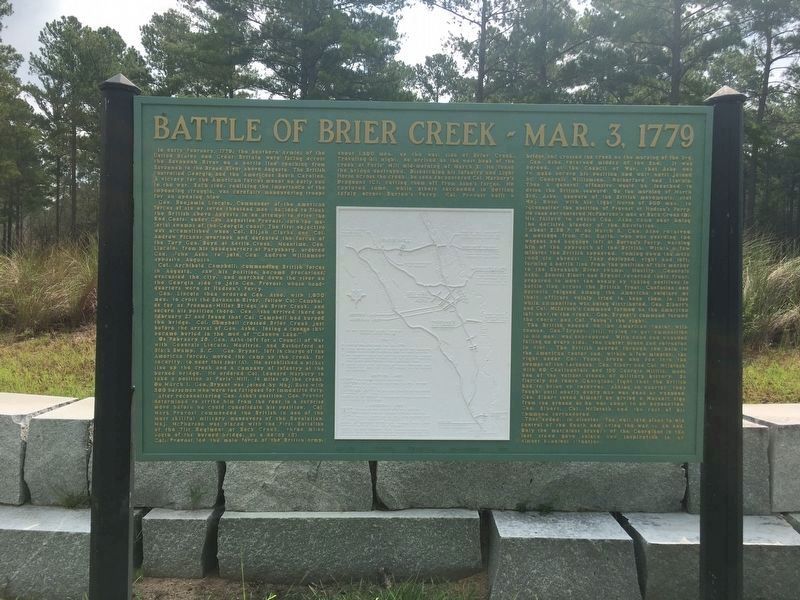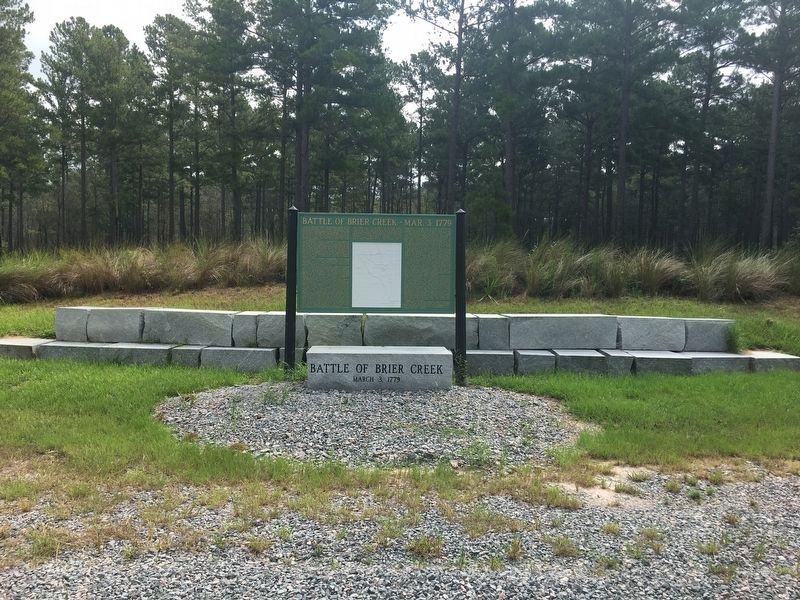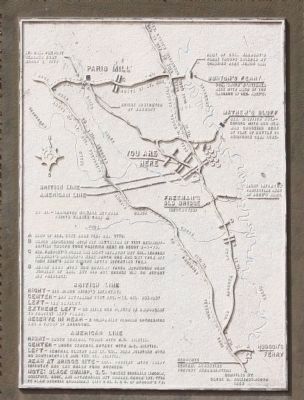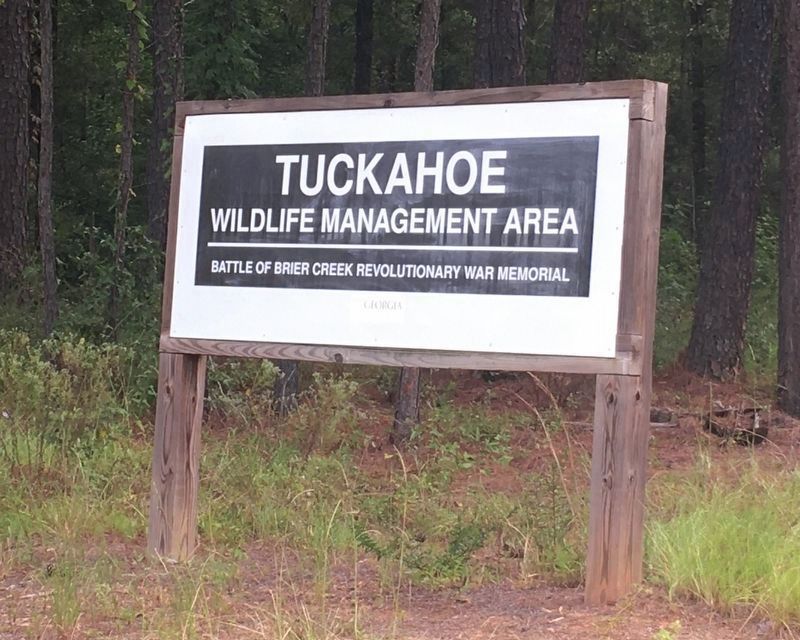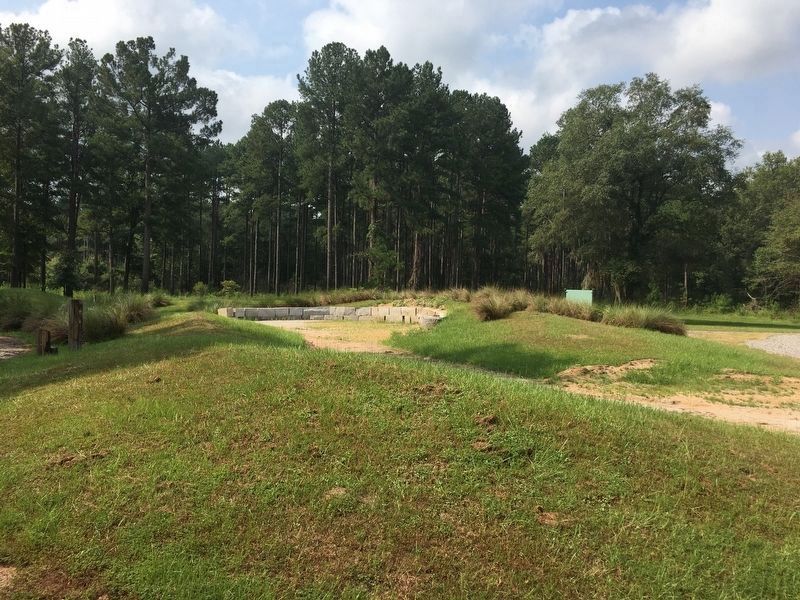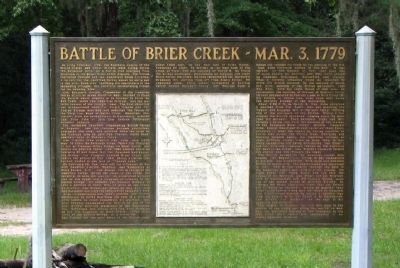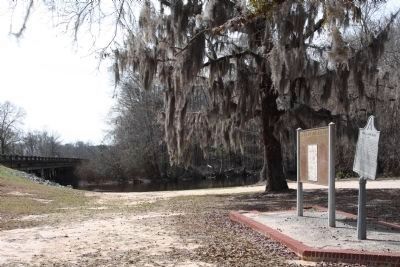Near Sylvania in Screven County, Georgia — The American South (South Atlantic)
Battle of Brier Creek - Mar. 3, 1779
Gen. Benjamin Lincoln, Commander of the American forces of six or seven thousand men, decided to flank the British above Augusta in an attempt to drive the Red Coats, under Gen. Augustine Prevost, into the malarial swamps of the Georgia coast. The first objective was accomplished when Col. Elijah Clarke and Col. Andrew Pickens overtook and defeated the forces of the Tory Gen. Boyd at Kettle Creek. Meantime, Gen. Lincoln, from his headquarters at Purysburg, ordered Gen. John Ashe to join Gen. Andrew Williamson opposite Augusta.
Col. Archibald Campbell, commanding British forces in Augusta, saw his position become precarious, evacuated the city, and marched down the river on the Georgia side to join Gen. Prevost, whose headquarters were at Hudson`s Ferry.
Gen. Lincoln then ordered Gen. Ashe, with 1,800 men, to cross the Savannah River, follow Col. Campbell as far as Freeman-Miller Bridge on Brier Creek, and secure his position there. Gen. Ashe arrived there on February 27 and found that Col. Campbell had burned the bridge. Col. Campbell crossed Brier Creek just before the arrival of Gen. Ashe, losing a cannon that became buried in the mud of 'Cannon Lake.'
On February 28, Gen. Ashe left for a Council of War with Generals Lincoln, Moultrie, and Rutherford at Black Swamp, S.C. Gen. Bryant, left in charge of the American forces, moved the camp up the creek, for security, to near this spot (A). He established a picket line up the creek and a company of infantry at the burned bridge. He ordered Col. Leonard Marbury to take a position at Paris` Mill, 14 miles up the creek. On March 1, Gen. Bryant was joined by Maj. Ross with 300 horsemen who were too fatigued for immediate duty.
After reconnoitering Gen. Ashe's position, Gen. Prevost determined to strike him from the rear in a surprise move before he could consolidate his position. Col. Mark Prevost commanded the British in one of the most skillful military maneuvers of the Revolution. Maj. McPherson was placed with the First Battalion of the 71st Regiment at Buck Creek, three miles south of the burned bridge, as a decoy.
Col. Prevost led the main force of the British army, about 1,500 men, up the west side of Brier Creek. Traveling all night, he arrived on the west bank of the creek at Paris' Mill mid-morning of March 2. He found the bridge destroyed. Dispatching his Infantry and Light Horse across the creek, he soon encountered Col. Marbury's Dragoons, cutting them off from Ashe`s forces. He captured some, while others succeeded in getting safely across Burton's Ferry. Col. Prevost built a bridge and crossed the creek on the morning of the 3rd.
Gen. Ashe returned midday of the 2nd. It was agreed, at the Council of War, that Ashe was to make secure his position and wait until joined by Generals Williamson, Rutherford and Lincoln. Then a general offensive would be launched to drive the British seaward. On the morning of March 3rd, Ashe, unaware of the British movements, sent Maj. Ross, with his Light Horse of 300 men, to reconnoiter the position of Prevost at Hudson's Ferry. He soon encountered McPherson's men at Buck Creek. His failure to advise Gen. Ashe came near being the decisive blunder of the Revolution.
About 2:30 P.M. on March 3, Gen. Ashe received a message from Col. Smith, who was guarding the wagons and baggage left at Burton's Ferry, warning him of the approach of the British. Within a few minutes the British appeared, coming down the main road six abreast. They deployed, right and left, forming a battle line from the position of this marker to the Savannah River swamp. Hastily, Generals Ashe, Samuel Elbert and Bryant reversed their front, prepared to meet the enemy by taking positions in battle line across the British front. Confusion and hysteria reigned among the American soldiers as their officers vainly tried to keep them in line while ammunition was being distributed. Gen. Elbert`s and Col. McIntosh's command formed on the American left next to the creek, Gen. Bryant's command formed the center and Col. Young's the right.
The British opened on the American center with cannon. Gen. Bryant, still trying to get ammunition to his men, was unprepared. With dead and wounded falling on every side, the center broke and retreated in riot. The British poured through the hole in the American center and within a few minutes, the right under Col. Young broke and ran into the swamps of the Savannah. Gen. Elbert and Col. McIntosh, with 60 Continentals and 150 Georgia Militia, made one of the valiant stands of military history. So fiercely did these Georgians fight that the British had to bring up reserves. Asking no quarter, they fought until nearly every man was dead or wounded. Gen. Elbert saved himself by giving a Masonic sign from the ground as he was about to be bayonetted. Gen. Elbert, Col. McIntosh and the rest of his command surrendered.
Thus ended, in disaster, the well laid plans to win control of the South and bring the war to an end. Only the matchless bravery
of the Georgians in the
last stand gave solace and inspiration in an almost hopeless situation.
Erected 1956 by Georgia Historical Commission. (Marker Number 124-20.)
Topics and series. This historical marker is listed in this topic list: War, US Revolutionary. In addition, it is included in the Georgia Historical Society series list. A significant historical date for this entry is March 3, 1779.
Location. 32° 48.326′ N, 81° 28.28′ W. Marker is near Sylvania, Georgia, in Screven County. Marker is on an unnamed gravel road, 0.1 miles west of Brannens Bridge Road. From the intersection of Old River Road and Pine Grove Inn Road, go southeast one mile. During this mile the name of the road changes to Brannens Bridge Road. Turn left onto a gravel road at the sign reading “Tuckahoe Wildlife Management Area — Battle of Brier Creek Revolutionary War Memorial.” The memorial will be one tenth of a mile down the gravel road at the fork. Touch for map. Marker is in this post office area: Sylvania GA 30467, United States of America. Touch for directions.
Other nearby markers. At least 8 other markers are within 9 miles of this marker, measured as the crow flies. General Samuel Elbert (a few steps from this marker); Washington Slept Here (approx. 6 miles away); Wesleyanna Memorial Church (approx. 6.4 miles away); John Abbot (approx. 8.9 miles away); The Goodall House
(approx. 8.9 miles away); The 14th Corps (approx. 8.9 miles away); Washington's Route (approx. 8.9 miles away); Jacksonboro (approx. 8.9 miles away). Touch for a list and map of all markers in Sylvania.
More about this marker. This is the second largest marker, and the largest free-standing marker, in Georgia.
Marker was originally located at approximately 32° 48.651′ N, 81° 29.035′ W. on Brannen's Bridge Road at Brier Creek, 1.1 miles south of Old River Road, on the left. The marker adjoined the monopole “General Samuel Elbert” in a small park with a picnic pavilion.
Also see . . . The Battle of Brier Creek. Summary of the battle. (Submitted on September 8, 2008, by Craig Swain of Leesburg, Virginia.)
Credits. This page was last revised on September 4, 2023. It was originally submitted on September 7, 2008, by David Seibert of Sandy Springs, Georgia. This page has been viewed 4,622 times since then and 98 times this year. Last updated on September 2, 2023, by Barry Snyder of Melbourne, Florida. Photos: 1, 2. submitted on September 2, 2023, by Barry Snyder of Melbourne, Florida. 3. submitted on February 22, 2009, by Mike Stroud of Bluffton, South Carolina. 4, 5. submitted on September 2, 2023, by Barry Snyder of Melbourne, Florida. 6. submitted on September 7, 2008, by David Seibert of Sandy Springs, Georgia. 7. submitted on February 22, 2009, by Mike Stroud of Bluffton, South Carolina. • J. J. Prats was the editor who published this page.
